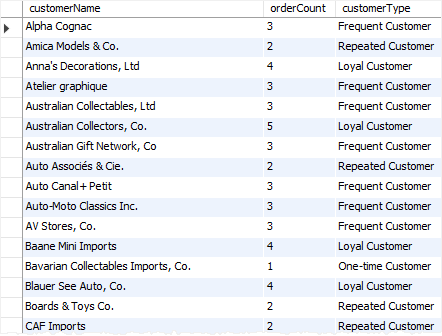Summary: in this tutorial, you will learn how to use the MySQL CASE expression to add if-else logic to queries.
Introduction to MySQL CASE expression
MySQL CASE expression is a control flow structure that allows you to add if-else logic to a query. Generally speaking, you can use the CASE expression anywhere that allows a valid expression e.g., SELECT, WHERE and ORDER BY clauses.
The CASE expression has two forms: simple CASE and searched CASE.
Note that MySQL has a CASE statement that you can use only in stored programs such as stored procedures, stored functions, events, and triggers, which is not the CASE expression covered in this tutorial.
Simple CASE expression
The following illustrates the syntax of a simple CASE expression:
CASE value
WHEN value1 THEN result1
WHEN value2 THEN result2
…
[ELSE else_result]
ENDCode language: SQL (Structured Query Language) (sql)In this syntax, CASE matches the value with the value1, value2, etc., for equality and return the corresponding result1, result2,… If the value does not equal to any value1, value2, … CASE returns the result in the ELSE clause if the ELSE clause is specified.
The CASE compares the value with values in the WHEN clauses for equality, you cannot use it with NULL because NULL = NULL returns false.
Searched CASE expression
The following shows the syntax of a searched CASE expression:
CASE
WHEN expression1 THEN result1
WHEN expression2 THEN result2
…
[ELSE else_result]
ENDCode language: SQL (Structured Query Language) (sql)In this syntax, the CASE evaluates expressions specified in the WHEN clauses. If an expression evaluates to true. CASE returns the corresponding result in the THEN clause. Otherwise, it returns the result specified in the ELSE clause. In case the ELSE clause is not available, then the CASE expression returns NULL .
The CASE expression returns a result whose data type depends on the context where it is used. For example, if the CASE expression is used in the character string context, it returns the result as a character string. If the CASE expression is used in a numeric context, it returns the result as an integer, a decimal, or a real value.
MySQL CASE expression examples
1) Using CASE expression in the SELECT clause example
See the following orders and customers tables:

The following statement returns the customers and their orders:
SELECT
customerName,
COUNT(*) orderCount
FROM
orders
INNER JOIN customers
USING (customerNumber)
GROUP BY customerName
ORDER BY COUNT(*);Code language: SQL (Structured Query Language) (sql)
This example uses the CASE expression in the SELECT clause to return the type of customers based on the number of orders that customers ordered:
WITH cte AS (
SELECT
customerName,
COUNT(*) orderCount
FROM
orders
INNER JOIN customers
USING (customerNumber)
GROUP BY customerName
)
SELECT
customerName,
orderCount,
CASE orderCount
WHEN 1 THEN 'One-time Customer'
WHEN 2 THEN 'Repeated Customer'
WHEN 3 THEN 'Frequent Customer'
ELSE 'Loyal Customer'
end customerType
FROM
cte
ORDER BY customerName;Code language: SQL (Structured Query Language) (sql)
2) Using CASE expression in the ORDER BY clause example
The following example uses the CASE expression to sort customers by state if the state is not NULL, or sort the country in case the state is NULL:
SELECT
customerName,
state,
country
FROM
customers
ORDER BY (
CASE
WHEN state IS NULL
THEN country
ELSE state
END);Code language: SQL (Structured Query Language) (sql)
3) Using CASE expression with an aggregate function example
The following example uses the CASE expression with the SUM() function to calculate the total of sales orders by order status:
SELECT
SUM(CASE
WHEN status = 'Shipped' THEN 1
ELSE 0
END) AS 'Shipped',
SUM(CASE
WHEN status = 'On Hold' THEN 1
ELSE 0
END) AS 'On Hold',
SUM(CASE
WHEN status = 'In Process' THEN 1
ELSE 0
END) AS 'In Process',
SUM(CASE
WHEN status = 'Resolved' THEN 1
ELSE 0
END) AS 'Resolved',
SUM(CASE
WHEN status = 'Cancelled' THEN 1
ELSE 0
END) AS 'Cancelled',
SUM(CASE
WHEN status = 'Disputed' THEN 1
ELSE 0
END) AS 'Disputed',
COUNT(*) AS Total
FROM
orders;Code language: SQL (Structured Query Language) (sql)Here is the output:

How it works.
- First, the
CASEstatement returns 1 if the status equals the corresponding status such as Shipped, on hold, in Process, Cancelled, Disputed, and zero otherwise. - Second, the
SUM()function returns the total number of orders per order status.
In this tutorial, you have learned how to use the MySQL CASE expression to add if-else logic to the queries.